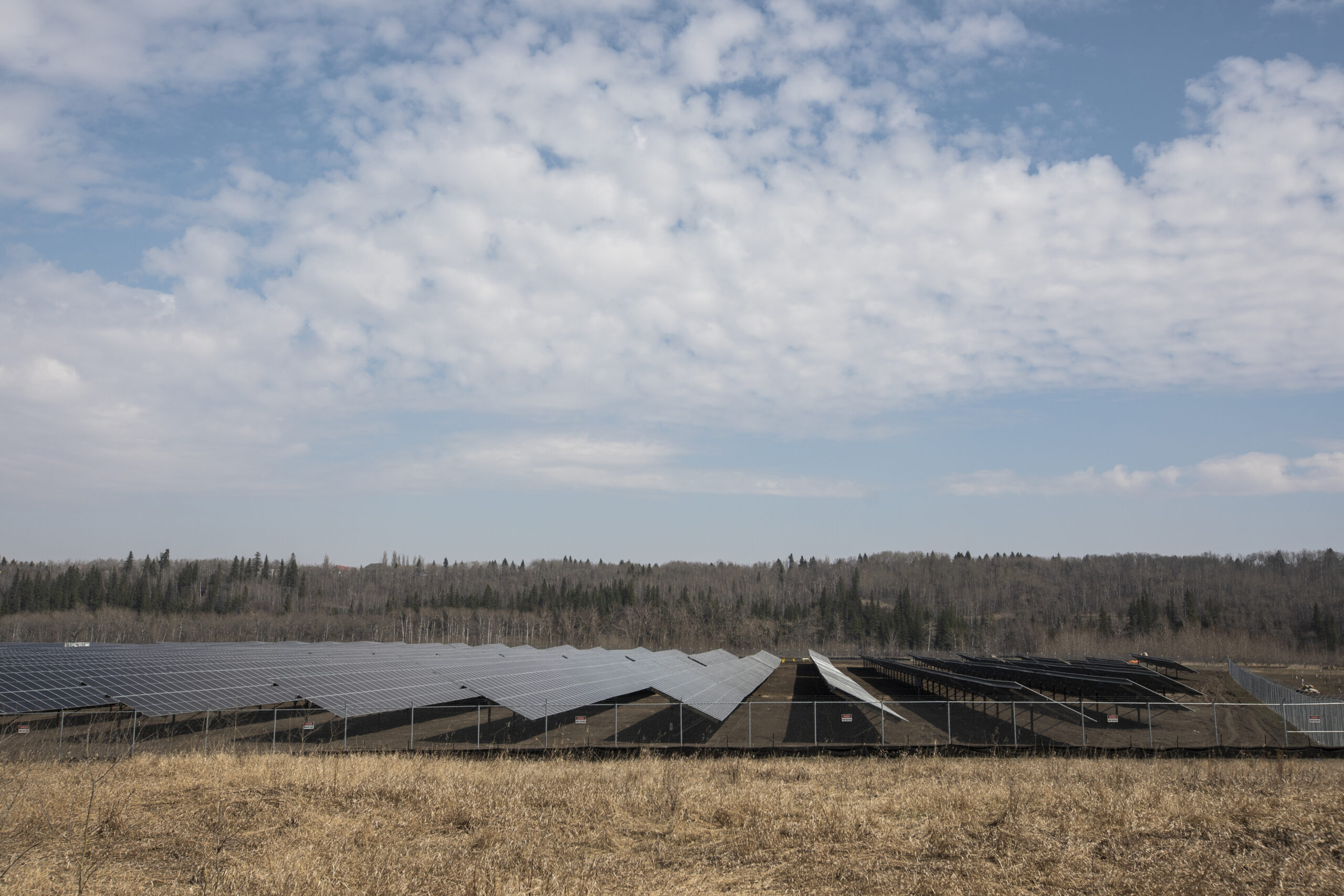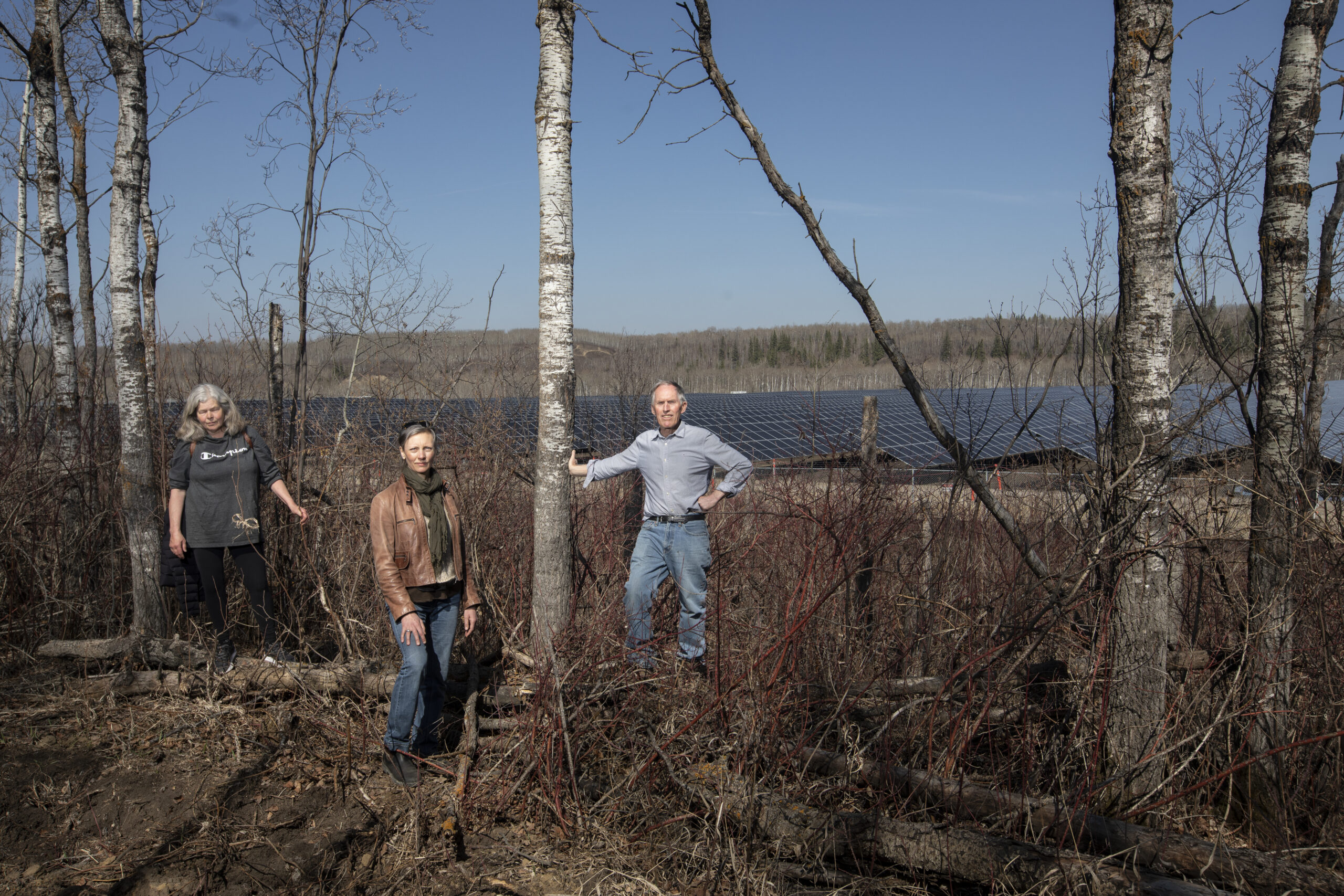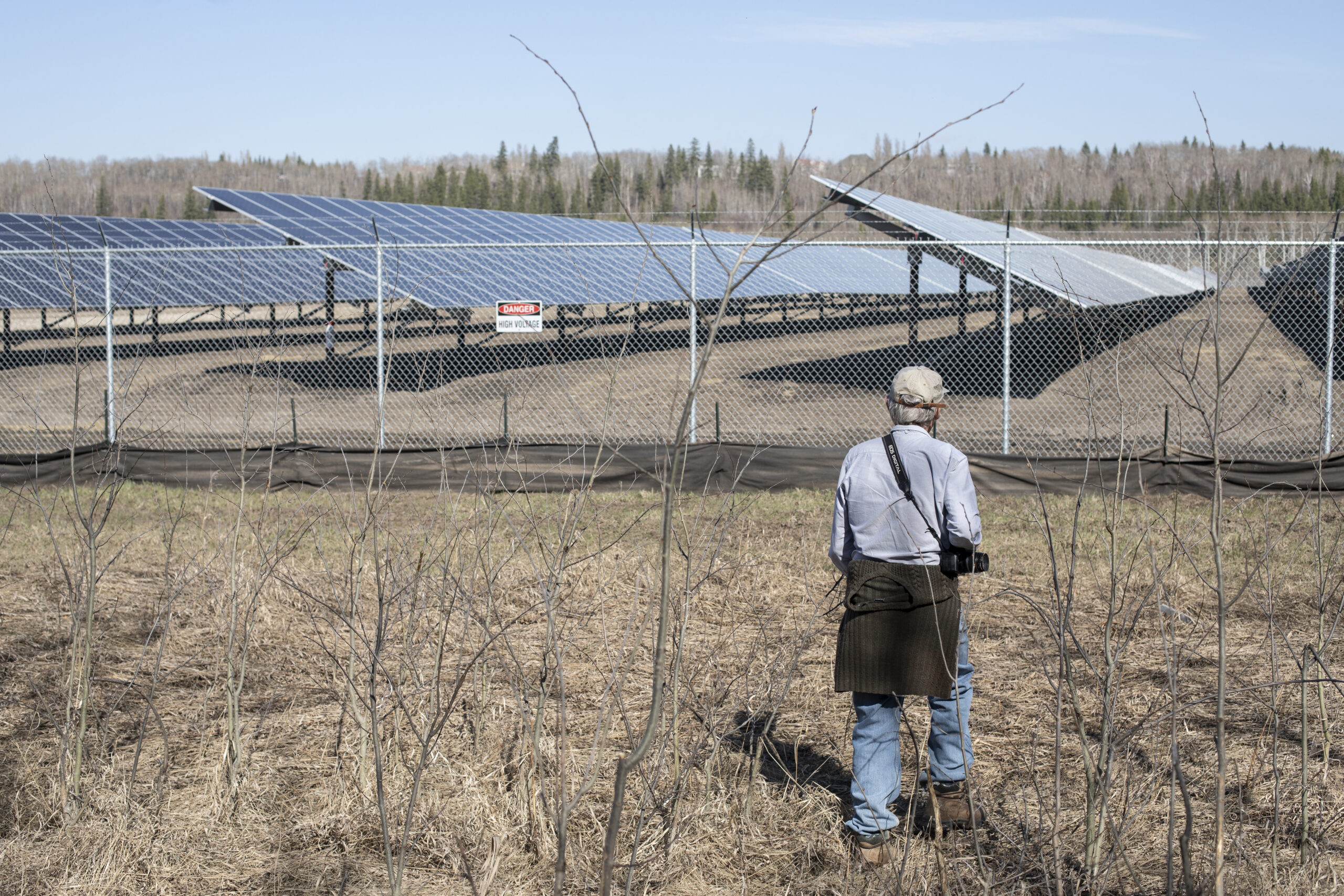
‘Afraid of the water’? Life in a city that dumps billions of litres of raw sewage into lakes and rivers
10 billion litres of sewage are dumped into Winnipeg’s lakes and rivers each year. Some...
A diagonal green squiggle right through the heart of Edmonton, the North Saskatchewan River Valley is one of the capital’s defining features and likely one of the first things on an Edmontonian’s list of things they love about their city. Animals like it too, using it as a corridor to bypass all the concrete laid for humans to travel.
Long before the city sprung up, the valley was an important gathering place for Indigenous people — Nehiyaw, Denesuliné, Nakota Sioux, Anishinaabe and Niitsitapi — for trade, ceremony, food, water, medicine and more.
The valley is still a gathering place, but it has changed.
It is now a mashup of green spaces, golf courses, homes, a zoo and more. But it is special enough that it has its own municipal bylaw that restricts development unless a project is deemed essential to the location.
Along the circuitous valley is a field that was taken from the Enoch Cree reserve lands over 100 years ago. It sits next to a water treatment plant operated by the city-owned utility company Epcor and has become the centre of controversy over the past few years as the company first pitched and then moved forward with a plan to build a solar farm on the site.
Opponents say the renewable energy project will have negative impacts on wildlife, leave a blemish on the cherished river valley and cover up a potentially rich First Nations cultural site. The company and the city say it is an important step toward climate resiliency.
The solar project highlights a unique tension that can arise as countries race to increase renewable energy in the face of a deepening climate crisis — how to achieve green energy without inflicting more harm on Indigenous communities and pitting one environmental good against another.
“As we are shifting towards green energy, we have to respect ecosystems, we have to respect culture, and I think if we’re not doing that then we’re making a major mistake and we’re just engaging in that same extractionist thinking as we did with fossil fuels,” Kristine Kowalchuk with the Edmonton River Valley Conservation Coalition says.
“So my thinking is, it’s not actually green if it destroys nature.”
Epcor’s E.L. Smith water treatment plant sits on a wide flat expanse of land that juts out into the North Saskatchewan on the western edge of Edmonton. Surrounded by trees on three sides, the southern portion of those Epcor lands are a large field slated for possible expansion of the plant some years in the future.
The field, which sat empty and partially fenced for years, is now the site of Epcor’s controversial solar project, and largely covered with panels that will eventually connect to onsite battery storage, feeding energy not only to the water treatment facility, but back into the wider electrical grid as well.
Epcor says the 45,000 solar panels that will make up the farm will reduce the company’s overall greenhouse gas emissions by 20 per cent, the equivalent of taking 2,500 vehicles off the road each year. The water treatment plant is the company’s second largest emitter in the Edmonton area.
“Overall, it is about immediate reductions in greenhouse gas emissions to help meet City of Edmonton goals and obviously generating local sources of renewable electricity, also in advancing the city’s energy transition strategy and we’re hoping this is also a catalyst for more climate action,” Trina Manning, Epcor’s senior manager of water plants projects says.
“Looking at Epcor specifically, it significantly reduces Epcor’s Edmonton greenhouse gas emissions, and helps us meet our own green or climate change targets.”

The company’s commissioned assessment of the project — looking at environmental, social and financial costs — determined that it was the best option compared to sourcing renewables offsite, constructing their own farm elsewhere or placing the panels on the roof of the existing building.
It found that with mitigation measures in place, impacts to wildlife and habitat “are anticipated to not be significant.”
That assessment, however, was roundly rejected by the city’s own review of the project, obtained by the Edmonton River Valley Conservation Coalition through a freedom of information request and provided to The Narwhal.
“Overall, the draft [environmental impact assessment] is very weak on, and in many areas lacks, data and/or references to support its conclusions around wildlife connectivity and habitat impacts,” reads the review. “This results in the report’s inability to rigorously support its final conclusion that no significant wildlife impact exists due to the project.”
The same city report questioned the valuation used to justify the project in that specific location, saying the land was worth far more — based on social, environmental and financial considerations — than Epcor indicated.
Epcor stood by its commissioned findings. But it shifted the project further back from the river after hearing public feedback and gave some land back to the city for trails, although the farm itself will be fenced off. It will plant native vegetation along the perimeter and partner with schools to study the smart grid and battery system.
The land was slated for future expansion of the water treatment plant regardless, according to Epcor, and it is simply putting that excess space to use for the next 25 years — the anticipated lifespan of the solar farm.
The project will also include historic site interpretation. Archaeological surveys prior to construction found evidence of First Nations use dating back almost 9,000 years.
“There’s definitely a strong Indigenous connection to the land,” Manning says. “That’s an incredibly important part of the project. So we have done a lot of work. And we’ve learned through this project in a lot of ways as well.”
Epcor signed a memorandum of understanding with the nearby Enoch Cree Nation as a result of the solar farm that establishes a more formal structure to discuss projects and address concerns ahead of time — although not all in the nation are satisfied.
There are no pickup trucks with Canadian flags blockading the water treatment site, no masses of people in I Love Alberta Oil and Gas hoodies shouting down solar energy developments in Edmonton.
The opponents of the solar farm are those who would normally be strong proponents of a swath of photovoltaic panels. In fact, they and just about everyone else who spoke to the project at public meetings and council debates, want to see renewable energy flourish.
“Would they put a solar field in Central Park or in Stanley Park?” Eric Gormley, with the Edmonton River Valley Conservation Coalition says. “I’m assuming they wouldn’t.”
The organization, of which Gormley and Kowalchuk are a part, has been a staunch opponent of the solar farm project since the beginning, arguing the location was inappropriate and more work needed to be done to conserve the valley, not develop it.
It says the area is a rich wildlife corridor as well as a prime location for a city park.

The organization argues the farm could be placed in other locations, and points to the city’s own river valley bylaw that prevents development unless the project is deemed essential to that location. It recently lost a judicial review of the project’s approval and is trying to raise funds to appeal that ruling.
“To take all that land, which is a pretty good sized chunk of land, 54 acres, and fence it and take all that land out of habitat, it just seemed like, whoa, what’s happening here?” Gormley says.
“And solar panels could go, you know, pretty much anywhere.”
He says the solar project, as well as an LRT bridge recently built in the valley, are a form of greenwashing to make incursions into an area that should be protected.
The project came before Edmonton’s city council for a final decision in 2020. The farm had already been approved by the Alberta Utilities Commission, but council had to decide whether to change the zoning on the land from a river valley parkland to allow the project to move forward.
Andrew Knack, a current city councillor who voted against the project, says his mind hasn’t changed over the past two years. He wants to see the site maintained as a natural river valley location and for Epcor to find another site for the farm.
“I’m still not sure if in 30 years time that land is going to be needed for an expansion of the water treatment plant,” he says, pointing to potential changes in technology. “So that’s why I opposed it.”
Speaking during the council debate in 2020, his colleague was more blunt.
“I find it very disturbing to pit two environmental priorities against each other in such a fashion, in such a way, and frankly I find Epcor’s position on this matter disturbing, but that is another matter for future discussion,” Mike Nickel, a councillor at the time, said.
Even the city’s own energy transition and climate resilience committee spoke against the project at the meeting, but noted it was a divisive topic for its members.
Council approved the rezoning, and therefore the project, by a vote of seven to six.
During that city debate in 2020, the meeting heard from one councillor from the Enoch Cree Nation, there on behalf of the chief, to lend support to the project after the nation initially opposed the development based on the findings of the archaeological excavations.
“We recognize that development in a river valley isn’t always ideal, but sometimes they’re necessary,” Coun. Michelle Wilsdon told the meeting. “You know, if this land had not been taken from us in 1908, we may very well have built our own water treatment plant there to supply water to our community, and may very well have also supported a solar solar project there as well.”
The nation, she said, is of the view that ceremonies would have certainly taken place on the site at some point in time, but noted they would likely have taken place across the valley.
Enoch Cree Coun. Lyle Morin also spoke at that meeting, but in opposition to the farm. Two years later, he remains opposed to the project.
“Just because they got some leadership to agree, doesn’t mean that they’re right,” Morin says.
He says the whole river valley is a special place, not just for the Enoch Cree, but for all the nations that would gather in that place over thousands of years. It is one aspect of the memorandum of understanding signed between Epcor and the Enoch Cree that does not sit well with him.
“There are more nations to be considered here,” he says. “And they’re not being considered.”
Morin says the memorandum does not lay a solid groundwork for co-operation, establish protocols for how to develop in the area or how to prevent development if and when cultural sites are identified. He wants a broader and deeper agreement between the city and all other parties about ensuring First Nations are on the ground when their traditional lands are dug up.
The archaeological excavation prior to construction only examined small pockets of the field.
“Stop digging in our graveyards and our ceremonial lands,” Morin says. “Stop it.”
The office of Enoch Cree Chief William Morin did not respond to an interview request.
Edmonton is not alone in confronting fallout from renewable energy projects that cause conflict or harm.
“Renewable energy projects, including dams and wind farms, are associated with serious human rights abuses including in Central and South America, East Africa and Southeast Asia,” reads a report from the Business and Human Rights Resource Centre, an international think tank and advocacy organization.
“Local communities are faced with some of the most damaging impacts including dispossession of their lands, livelihoods undermined, threats and intimidation, killings, displacement, among other abuses.”
The same report says a failure to adequately consult Indigenous communities has resulted in rising levels of resistance in many countries.
Resistance to development is nothing new, and resource projects in general have a long history of opposition — from mining to oil and gas to forestry. Renewable energy, however, has the potential to make allies of long-time opponents of things like fossil fuel development.
In B.C., the West Moberly First Nation has been fighting against the Site C hydro dam, arguing it infringes on their Treaty Rights. A planned court case between the nation and BC Hydro was paused when they entered into negotiations that have not yet concluded. West Moberly’s land will be flooded as the dam rises the waters of the Peace River.
Along the Canada-U.S. border, a fierce battle is being fought over bringing hydro power to the U.S. from Quebec, with an unlikely coalition of environmentalists, residents, First Nations and competing energy companies opposed to the project.
Further afield, the Sami people in Norway are fighting against wind turbines installed by a state-controlled company after the wind project scared away the reindeer that are central to the Sami way of life.

Alberta has policies in place to guide the development of solar projects, including where they should not be installed, but urban areas don’t have the same protections as more natural areas.
Rebecca Kauffman, a staff counsel for the Edmonton-based Environmental Law Centre and the author of its report into solar laws in Alberta, says the province has some positive regulations and policies including the wildlife directive for solar energy projects.
The directive prohibits solar projects in valleys where permanent water bodies are located, such as the North Saskatchewan River. The problem? The directive does not apply within the city.
“Their reasoning is that municipal areas likely mean that it is already disturbed land, which might make sense for a warehouse putting solar on the rooftop,” Kauffman says. “That is obviously not going to have the same impact as a greenfield setting.”
Kauffman argues there has to be more focus on land use planning in partnership between different levels of government to better organize where and when renewable projects can move forward and to avoid conflicts before they arise.
The fact the wildlife directive did not apply in Edmonton meant the Alberta Utilities Commission did not consider those regulations in its approval of the project.
Kauffman says other jurisdictions are better at providing incentives to nudge developers of solar projects away from easy-to-build locations and into brownfields or on rooftops.
“We shouldn’t be repeating the errors of the past. We need renewable energy, but at what cost?” Kauffman says.
“And I think it’s always a balancing act when you’re pushing for renewable energy quickly to make sure that it’s being done in a way that doesn’t repeat the same problems.”
Jim Stang, a spokesperson for the City of Edmonton, says the city has a goal and strategy for achieving net-zero emissions by 2050 and is examining district energy plans across the city.
“Zoning and planning play a role in enabling and encouraging renewable energy projects,” Stang says in an email response.
He says the city is looking at how regulations can better encourage renewable energy and energy efficiency in the city, and notes larger renewable energy projects “will continue to be zoned and permitted in suitable areas.”
The Edmonton River Valley Conservation Coalition is in a tough spot. When the judicial review it launched sided with Epcor, the judge also ordered the coalition to reimburse $33,000 in legal costs to the company.
The not-for-profit doesn’t have that kind of cash and a recent online campaign to help fund an appeal of that review has so far failed to reach its target. Kowalchuk says the organization has to decide soon whether it can afford to continue its fight.
“We raised a fair amount and in a small period of time, but it’s hard with projects like this,” she says. “I guess because of the greenwashing that happens, I mean, solar energy, right? If we were fighting against a coal mine here, we probably would have met our goals more easily.”
Kowalchuk argues this goes beyond Edmonton and its river valley and could set a precedent for future solar and renewable projects across the province.
If her organization’s appeal does move ahead and is successful, it’s unclear what would happen with the nearly complete solar farm. Kowalchuk and Gormley would like to see it come down and the land restored.
“What a waste. When you think about the archaeological potential of that land, plus the beautiful habitat, and a beautiful spot for a park for people to enjoy it, too,” Gormley says.
“Some places, they do seem to be special, and that was one of them.”
Get the inside scoop on The Narwhal’s environment and climate reporting by signing up for our free newsletter. On a warm September evening nearly 15...
Continue reading
10 billion litres of sewage are dumped into Winnipeg’s lakes and rivers each year. Some...

Court sides with Xatśūll First Nation, temporarily halting Mount Polley mine waste expansion

Break out the champagne: Emma’s storied life and leadership in journalism has earned her the...
